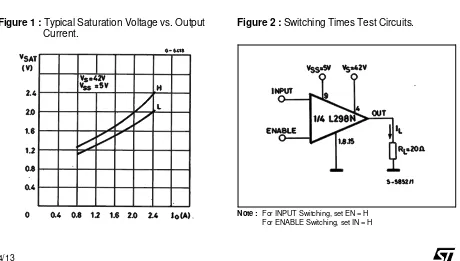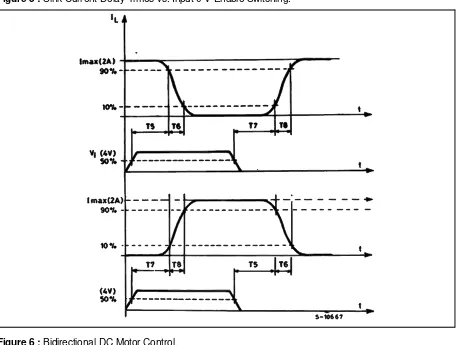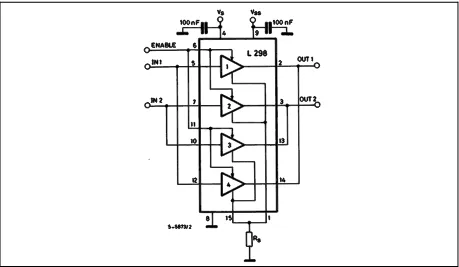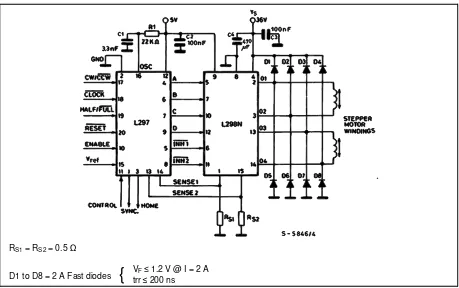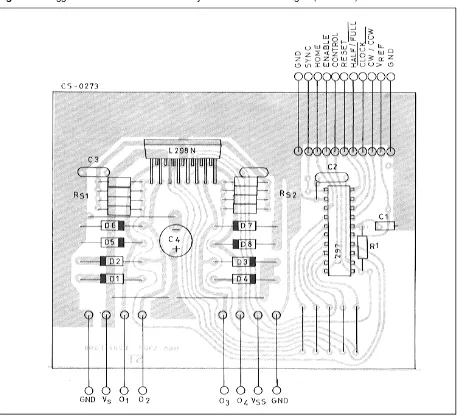DUAL FULL-BRIDGE DRIVER
Multiwatt15
ORDERING NUMBERS : L298N (Multiwatt Vert.) L298HN (Multiwatt Horiz.) L298P (PowerSO20)
BLOCK DIAGRAM
.
OPERATING SUPPLY VOLTAGE UP TO 46 V
.
TOTAL DC CURRENT UP TO 4 A
.
LOW SATURATION VOLTAGE
.
OVERTEMPERATURE PROTECTION
.
LOGICAL "0" INPUT VOLTAGE UP TO 1.5 V
(HIGH NOISE IMMUNITY)
DESCRIPTION
The L298 is an integrated monolithic circuit in a
15-lead Multiwatt and PowerSO20 packages. It is a
high voltage, high current dual full-bridge driver
de-signed to accept standard TTL logic levels and drive
inductive loads such as relays, solenoids, DC and
stepping motors. Two enable inputs are provided to
enable or disable the device independently of the
in-put signals. The emitters of the lower transistors of
each bridge are connected together and the
corre-sponding external terminal can be used for the
con-nection of an external sensing resistor. An additional
supply input is provided so that the logic works at a
lower voltage.
PIN CONNECTIONS
(top view)
GND
Input 2 VSS
N.C. Out 1 VS Out 2 Input 1 Enable A Sense A GND 10 8 9 7 6 5 4 3 2 13 14 15 16 17 19 18 20 12 1 11 GND D95IN239 Input 3 Enable B Out 3 Input 4 Out 4 N.C. Sense B GND
ABSOLUTE MAXIMUM RATINGS
Symbol Parameter Value Unit
VS Power Supply 50 V
VSS Logic Supply Voltage 7 V
VI,Ven Input and Enable Voltage –0.3 to 7 V
IO Peak Output Current (each Channel)
– Non Repetitive (t = 100µs)
–Repetitive (80% on –20% off; ton = 10ms)
–DC Operation 3 2.5 2 A A A
Vsens Sensing Voltage –1 to 2.3 V
Ptot Total Power Dissipation (Tcase = 75°C) 25 W
Top Junction Operating Temperature –25 to 130 °C
Tstg, Tj Storage and Junction Temperature –40 to 150 °C
THERMAL DATA
Symbol Parameter PowerSO20 Multiwatt15 Unit
Rth j-case Thermal Resistance Junction-case Max. – 3 °C/W
Rth j-amb Thermal Resistance Junction-ambient Max. 13 (*) 35 °C/W
(*) Mounted on aluminum substrate
1 2 3 4 5 6 7 9 10 11 8 ENABLE B INPUT 3
LOGIC SUPPLY VOLTAGE VSS
GND INPUT 2 ENABLE A INPUT 1
SUPPLY VOLTAGE VS
OUTPUT 2 OUTPUT 1
CURRENT SENSING A
TAB CONNECTED TO PIN 8
13 14 15
12
PIN FUNCTIONS
(refer to the block diagram)
MW.15 PowerSO Name Function
1;15 2;19 Sense A; Sense B Between this pin and ground is connected the sense resistor to control the current of the load.
2;3 4;5 Out 1; Out 2 Outputs of the Bridge A; the current that flows through the load connected between these two pins is monitored at pin 1. 4 6 VS Supply Voltage for the Power Output Stages.
A non-inductive 100nF capacitor must be connected between this pin and ground.
5;7 7;9 Input 1; Input 2 TTL Compatible Inputs of the Bridge A.
6;11 8;14 Enable A; Enable B TTL Compatible Enable Input: the L state disables the bridge A (enable A) and/or the bridge B (enable B).
8 1,10,11,20 GND Ground.
9 12 VSS Supply Voltage for the Logic Blocks. A100nF capacitor must be connected between this pin and ground.
10; 12 13;15 Input 3; Input 4 TTL Compatible Inputs of the Bridge B.
13; 14 16;17 Out 3; Out 4 Outputs of the Bridge B. The current that flows through the load connected between these two pins is monitored at pin 15.
– 3;18 N.C. Not Connected
ELECTRICAL CHARACTERISTICS
(V
S= 42V; V
SS= 5V, T
j= 25
°
C; unless otherwise specified)
Symbol Parameter Test Conditions Min. Typ. Max. Unit
VS Supply Voltage (pin 4) Operative Condition VIH +2.5 46 V
VSS Logic Supply Voltage (pin 9) 4.5 5 7 V
IS Quiescent Supply Current (pin 4) Ven = H; IL = 0 Vi = L
Vi = H
13 50 22 70 mA mA Ven = L Vi = X 4 mA
ISS Quiescent Current from VSS (pin 9) Ven = H; IL = 0 Vi = L
Vi = H
24 7 36 12 mA mA Ven = L Vi = X 6 mA
ViL Input Low Voltage
(pins 5, 7, 10, 12)
–0.3 1.5 V
ViH Input High Voltage
(pins 5, 7, 10, 12)
2.3 VSS V
IiL Low Voltage Input Current
(pins 5, 7, 10, 12)
Vi = L –10 µA
IiH High Voltage Input Current
(pins 5, 7, 10, 12)
Vi = H ≤ VSS –0.6V 30 100 µA
Ven = L Enable Low Voltage (pins 6, 11) –0.3 1.5 V
Ven = H Enable High Voltage (pins 6, 11) 2.3 VSS V
Ien = L Low Voltage Enable Current
(pins 6, 11)
Ven = L –10 µA
Ien = H High Voltage Enable Current
(pins 6, 11)
Ven = H ≤ VSS –0.6V 30 100 µA
VCEsat (H) Source Saturation Voltage IL = 1A
IL = 2A
0.95 1.35 2 1.7 2.7 V V VCEsat (L) Sink Saturation Voltage IL = 1A (5)
IL = 2A (5)
0.85 1.2 1.7 1.6 2.3 V V VCEsat Total Drop IL = 1A (5)
IL = 2A (5)
1.80 3.2
4.9 V V
Figure 1 :
Typical Saturation Voltage vs. Output
Current.
Figure 2 :
Switching Times Test Circuits.
Note : For INPUT Switching, set EN = H For ENABLE Switching, set IN = H 1) 1)Sensing voltage can be –1 V for t ≤ 50 µsec; in steady state Vsens min ≥ – 0.5 V.
2) See fig. 2. 3) See fig. 4.
4) The load must be a pure resistor.
ELECTRICAL CHARACTERISTICS
(continued)
Symbol Parameter Test Conditions Min. Typ. Max. Unit
T1 (Vi) Source Current Turn-off Delay 0.5 Vi to 0.9 IL (2); (4) 1.5 µs
T2 (Vi) Source Current Fall Time 0.9 IL to 0.1 IL (2); (4) 0.2 µs
T3 (Vi) Source Current Turn-on Delay 0.5 Vi to 0.1 IL (2); (4) 2 µs
T4 (Vi) Source Current Rise Time 0.1 IL to 0.9 IL (2); (4) 0.7 µs
T5 (Vi) Sink Current Turn-off Delay 0.5 Vi to 0.9 IL (3); (4) 0.7 µs
T6 (Vi) Sink Current Fall Time 0.9 IL to 0.1 IL (3); (4) 0.25 µs
T7 (Vi) Sink Current Turn-on Delay 0.5 Vi to 0.9 IL (3); (4) 1.6 µs
T8 (Vi) Sink Current Rise Time 0.1 IL to 0.9 IL (3); (4) 0.2 µs
fc (Vi) Commutation Frequency IL = 2A 25 40 KHz
T1 (Ven) Source Current Turn-off Delay 0.5 Ven to 0.9 IL (2); (4) 3 µs
T2 (Ven) Source Current Fall Time 0.9 IL to 0.1 IL (2); (4) 1 µs
T3 (Ven) Source Current Turn-on Delay 0.5 Ven to 0.1 IL (2); (4) 0.3 µs
T4 (Ven) Source Current Rise Time 0.1 IL to 0.9 IL (2); (4) 0.4 µs
T5 (Ven) Sink Current Turn-off Delay 0.5 Ven to 0.9 IL (3); (4) 2.2 µs
T6 (Ven) Sink Current Fall Time 0.9 IL to 0.1 IL (3); (4) 0.35 µs
T7 (Ven) Sink Current Turn-on Delay 0.5 Ven to 0.9 IL (3); (4) 0.25 µs
Figure 3 :
Source Current Delay Times vs. Input or Enable Switching.
Figure 4 :
Switching Times Test Circuits.
Figure 5 :
Sink Current Delay Times vs. Input 0 V Enable Switching.
Figure 6 :
Bidirectional DC Motor Control.
L = Low H = High X = Don’t care
Inputs Function
Ven = H C = H ; D = L Forward
C = L ; D = H Reverse C = D Fast Motor Stop Ven = L C = X ; D = X Free Running
Figure 7 :
For higher currents, outputs can be paralleled. Take care to parallel channel 1 with channel 4
and channel 2 with channel 3.
APPLICATION INFORMATION (Refer to the block diagram)
1.1. POWER OUTPUT STAGE
The L298 integrates two power output stages (A ; B).
The power output stage is a bridge configuration
and its outputs can drive an inductive load in
com-mon or differenzial mode, depending on the state of
the inputs. The current that flows through the load
comes out from the bridge at the sense output : an
external resistor (R
SA; R
SB.) allows to detect the
in-tensity of this current.
1.2. INPUT STAGE
Each bridge is driven by means of four gates the
in-put of which are In1 ; In2 ; EnA and In3 ; In4 ; EnB.
The In inputs set the bridge state when The En input
is high ; a low state of the En input inhibits the bridge.
All the inputs are TTL compatible.
2. SUGGESTIONS
A non inductive capacitor, usually of 100 nF, must
be foreseen between both Vs and Vss, to ground,
as near as possible to GND pin. When the large
ca-pacitor of the power supply is too far from the IC, a
second smaller one must be foreseen near the
L298.
The sense resistor, not of a wire wound type, must
be grounded near the negative pole of Vs that must
be near the GND pin of the I.C.
Each input must be connected to the source of the
driving signals by means of a very short path.
Turn-On and Turn-Off : Before to Turn-ON the
Sup-ply Voltage and before to Turn it OFF, the Enable
in-put must be driven to the Low state.
3. APPLICATIONS
Fig 6 shows a bidirectional DC motor control
Sche-matic Diagram for which only one bridge is needed.
The external bridge of diodes D1 to D4 is made by
four fast recovery elements (trr
≤
200 nsec) that
must be chosen of a VF as low as possible at the
worst case of the load current.
The sense output voltage can be used to control the
current amplitude by chopping the inputs, or to
pro-vide overcurrent protection by switching low the
en-able input.
The brake function (Fast motor stop) requires that
the Absolute Maximum Rating of 2 Amps must
never be overcome.
When the repetitive peak current needed from the
load is higher than 2 Amps, a paralleled
configura-tion can be chosen (See Fig.7).
This solution can drive until 3 Amps In DC operation
and until 3.5 Amps of a repetitive peak current.
On Fig 8 it is shown the driving of a two phase bipolar
stepper motor ; the needed signals to drive the
in-puts of the L298 are generated, in this example,
from the IC L297.
Fig 9 shows an example of P.C.B. designed for the
application of Fig 8.
Fig 10 shows a second two phase bipolar stepper
motor control circuit where the current is controlled
by the I.C. L6506.
Figure 8 :
Two Phase Bipolar Stepper Motor Circuit.
This circuit drives bipolar stepper motors with winding currents up to 2 A. The diodes are fast 2 A types.
RS1 = RS2 = 0.5 Ω
Figure 9 :
Suggested Printed Circuit Board Layout for the Circuit of fig. 8 (1:1 scale).
Figure 10 :
Two Phase Bipolar Stepper Motor Control Circuit by Using the Current Controller L6506.
Multiwatt15 V
DIM. mm inch
MIN. TYP. MAX. MIN. TYP. MAX.
A 5 0.197
B 2.65 0.104
C 1.6 0.063
D 1 0.039
E 0.49 0.55 0.019 0.022
F 0.66 0.75 0.026 0.030
G 1.02 1.27 1.52 0.040 0.050 0.060 G1 17.53 17.78 18.03 0.690 0.700 0.710
H1 19.6 0.772
H2 20.2 0.795
L 21.9 22.2 22.5 0.862 0.874 0.886 L1 21.7 22.1 22.5 0.854 0.870 0.886
L2 17.65 18.1 0.695 0.713
L3 17.25 17.5 17.75 0.679 0.689 0.699 L4 10.3 10.7 10.9 0.406 0.421 0.429
L7 2.65 2.9 0.104 0.114
M 4.25 4.55 4.85 0.167 0.179 0.191 M1 4.63 5.08 5.53 0.182 0.200 0.218
S 1.9 2.6 0.075 0.102
S1 1.9 2.6 0.075 0.102
Dia1 3.65 3.85 0.144 0.152
DIM. mm inch
MIN. TYP. MAX. MIN. TYP. MAX.
A 5 0.197
B 2.65 0.104
C 1.6 0.063
E 0.49 0.55 0.019 0.022
F 0.66 0.75 0.026 0.030
G 1.14 1.27 1.4 0.045 0.050 0.055 G1 17.57 17.78 17.91 0.692 0.700 0.705
H1 19.6 0.772
H2 20.2 0.795
L 20.57 0.810
L1 18.03 0.710
L2 2.54 0.100
L3 17.25 17.5 17.75 0.679 0.689 0.699 L4 10.3 10.7 10.9 0.406 0.421 0.429
L5 5.28 0.208
L6 2.38 0.094
L7 2.65 2.9 0.104 0.114
S 1.9 2.6 0.075 0.102
S1 1.9 2.6 0.075 0.102
Dia1 3.65 3.85 0.144 0.152
Multiwatt15 H
JEDEC MO-166
PowerSO20
e a2 A E a1 PSO20MEC DETAIL A T D 1 11 20 E1 E2h x 45
DETAIL A lead slug a3 S Gage Plane 0.35 L DETAIL B R DETAIL B (COPLANARITY) G C C
-SEATING PLANE e3 b c N N H BOTTOM VIEW E3 D1
DIM. mm inch
MIN. TYP. MAX. MIN. TYP. MAX.
A 3.6 0.142
a1 0.1 0.3 0.004 0.012
a2 3.3 0.130
a3 0 0.1 0.000 0.004
b 0.4 0.53 0.016 0.021
c 0.23 0.32 0.009 0.013
D (1) 15.8 16 0.622 0.630
D1 9.4 9.8 0.370 0.386
E 13.9 14.5 0.547 0.570
e 1.27 0.050
e3 11.43 0.450
E1 (1) 10.9 11.1 0.429 0.437
E2 2.9 0.114
E3 5.8 6.2 0.228 0.244
G 0 0.1 0.000 0.004
H 15.5 15.9 0.610 0.626
h 1.1 0.043
L 0.8 1.1 0.031 0.043
N 10˚ (max.)
S
T 10 0.394
(1) "D and F" do not include mold flash or protrusions. - Mold flash or protrusions shall not exceed 0.15 mm (0.006"). - Critical dimensions: "E", "G" and "a3"
OUTLINE AND
MECHANICAL DATA
8˚ (max.)
Information furnished is believed to be accurate and reliable. However, STMicroelectronics assumes no responsibility for the conse-quences of use of such information nor for any infringement of patents or other rights of third parties which may result from its use. No license is granted by implication or otherwise under any patent or patent rights of STMicroelectronics. Specification mentioned in this publication are subject to change without notice. This publication supersedes and replaces all information previously supplied. STMi-croelectronics products are not authorized for use as critical components in life support devices or systems without express written approval of STMicroelectronics.
The ST logo is a registered trademark of STMicroelectronics © 2000 STMicroelectronics – Printed in Italy – All Rights Reserved
STMicroelectronics GROUP OF COMPANIES
Australia Brazil China Finland France Germany Hong Kong India Italy Japan Malaysia Malta Morocco -Singapore - Spain - Sweden - Switzerland - United Kingdom - U.S.A.
